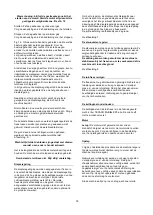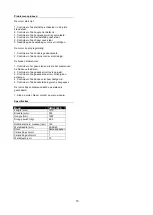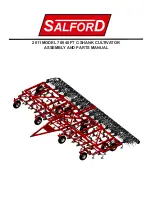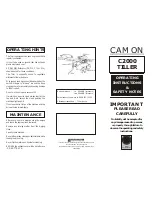
5
Clothing
When working with the tiller, wear close-fitting work
clothes, sturdy work gloves, hearing protection and boots
with non-skid ¨soles, and steel nose is compulsory.
Use
Clean the area of all foreign items before use. Stone,
glass, branches, etc. can damage the tiller. Check that all
bolts on the tiller are tightened.
Warning: Stay out of dashed zone, while starting the
engine! Always start the engine from dotted safety
zone See fig 10
Start:
Place the throttle handle on choker/full throttle.
Follow the guide in the user manual to start.
Stop:
Place the throttle handle on minimum throttle.
Follow the guide in the user manual to stop.
Fig 14: To use the black handle, the control stick must
first be activated. By tilting the control stick to the right or
left side and then activate the black handle, the tiller will
move forward or backwards.
Pay attention while reversing. It is important that the area
is cleared, for any obstacle before reversing. Never
reverse the tiller against a wall, tree or any other fixed
obstacle.
If the tiller has a tendency to dig down, there are several
things you can do. The right and left blade set can be
changed. This means that the tiller will use the reverse of
the blade to till, and thus it will not be so easy to dig
down. In addition, side guards can be fitted. This also
helps prevent the tiller from digging down. The depth skid
must always be placed in the top notch if this is the case.
See also the section on adjusting the depth skid.
In addition to the speed of the engine, the speed is
controlled by the depth skid, which is placed behind the
machine.
Do not cultivate in very wet soil as clods of soil will be
formed, and these are difficult to break. Dry and hard soil
may need to be cultivated twice.
The outer blades can be dismounted if the tiller is used
between narrow rows of plants and crops. This reduces
the tilling width.
The ground can be tilled in two directions, thus achieving
optimum tilling.
Figure 12.
Always wait until the blades have stopped rotating
before another handle is activated.
It is important, that you do not try to hold back the tiller. It
must be relaxing to use the machine.
Do not overload your tiller. Always drive carefully.
Adjusting the depth skid
The depth skid can be adjusting for tilling in three
different depths. The deeper the depth skid sits in the
soil, the deeper the tilling blades will work and the slower
the machine will advance. The right cultivating depth will
lighten your workload. The correct tilling depth depends
on the soil, and we recommend you make several
attempts to see how deep the depth skid should be so
that you can work optimally in your soil.
To adjust the depth skid, pull it backwards and up till the
preferred height is found. Place the depth skid vertically,
and it will fall into a notch. The depth skid can be
adjusted to various tilling depths. The deeper into the
ground the depth skid goes, the deeper the tiller will
work.The right setting depends on the soil.
See figure 7
Adjusting the support wheels
The support wheels are mounted on the tiller. They can
be adjusted to the required height by pulling the lock
handle and moving the ring up or down. The wheel ring
can be used to stabilise the machine when tilling and
also help to prevent the machine falling into soft soil.
See figure 8
Cleaning the tiller
The tiller should be cleaned after use. Use your garden
hose and wash off soil and dirt. Clean the rotor shaft of
any grass, etc. The chassis number should only be
cleaned with a moist cloth otherwise it may be damaged.
Avoid using a high pressure cleaner for cleaning.
Maintaining the gear box
The gear box on the tiller is lubricated at the factory with
0.2 litre TEXACO Multifak EP0 oil. It is not necessary to
renew the oil.
Engine
IMPORTANT:
The engine is delivered without oil and
fuel.
Remember to fill the engine with engine oil before
starting.
Follow the guidelines in the user manual for correct use
and maintenance of the engine.
Storage
Follow the procedure below when the machine is to be
unused for a long period. This will ensure the machine
has a long service life.
Use your garden hose to wash off any soil and dirt. Clean
the rotor shaft of any grass, etc. The chassis number
should only be cleaned with a moist cloth otherwise it
may be damaged. Avoid using a high pressure cleaner
for cleaning. Clean the body with a damp cloth so all the
surfaces are clean. The surface must be wiped with an
oily cloth to prevent rust.
You should always store your machine in a dry, clean
place.









































